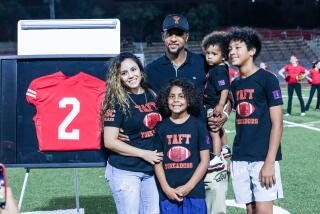Inner-City Baseball Program Gives Youth A Batting Chance
- Share via
Isaac Burton adjusted his grip on the ball, checked first base and stared out of the city ballpark into the setting sun.
The lanky 15-year-old pitcher nursed a slender lead and knew that a hit in this last inning could ruin everything, put two men on base and bring the Dukes’ best slugger to bat with only one out. Burton checked first again, then let loose his best--before a mighty swing rocketed a line drive to left field.
But in a blink of an eye, a racing Bisons outfielder scooped up the ball and hurled it home. Suddenly, the runner was out at the plate and, moments later, the hitter was trapped between second and third. Isaac smiled as he ran off the field, slapping his teammates’ hands. This night, the 13-, 14- and 15-year-olds were champions of the Harvard Recreation Center and had won the right to play the winners from a neighboring park.
For an instant, John T. Young, 40, founder of Reviving Baseball in Inner Cities, could see his field of dreams here in South-Central Los Angeles turn into reality.
‘I Was a Rough Kid’
With the blessing of major league baseball, the city of Los Angeles and the Los Angeles Unified School District, Young and a group of boyhood friends have worked since 1987 to re-create the circumstances of their youth, when baseball was their love and, ultimately, the path that led out of the inner city to college and beyond.
“I grew up in South-Central L.A., and I played at the parks, which we are using now, as a kid, and I was a rough kid,” said Young, a major league scout who grew up near 103rd Street and San Pedro St.
“I see myself in some of these kids . . . doing dangerous stuff. . . . If it wasn’t for baseball, I’d be right there with them.”
The premise for the RBI program was grounded in stark reality for Young, a 10-year veteran of professional baseball. In 1987, as a scout for the Texas Rangers, he surveyed about 40 Southern California college baseball teams and found that fewer than 5% of the players were Latino; fewer than 4% were black.
Statistics Spelled a Problem
To Young, those statistics, combined with the fact that 81% of the players drafted in baseball in 1986 came from college programs and that many major league players come from Southern California, spelled a problem for minority athletes and for baseball. The inner city’s best players are not winding up on a college track.
A program to fill the void after Little League and complement under-funded high school programs would give the major leagues a larger talent pool while getting more minorities into college, he reasoned.
“We’ll still be able to sign the high school kids who are ready to play professional baseball,” Young said, “but send to college those who aren’t ready.”
Young hopes that the program will mean a turnaround for inner-city minority students who face a high school dropout rate far greater than Los Angeles Unified’s three-year average of 39%. Each year, inner-city schools lose up to 35% of their students, compared to a districtwide rate of 16%, said Pete Martinez, coordinator of the district’s Dropout Prevention/Recovery Program.
RBI will also provide discipline and guidance, the Rangers scout said.
“There was always an adult there to help me grow up,” said Young, who played Little League at Los Angeles’ Rosecrans Recreation Center in the early 1960s. “There was always a coach. (Today in the inner city), I just don’t see enough dads, enough parents out there with the kids.”
One such father belonged to a childhood friend, Robert A. Adams, 41, who is now administrative dean of community and student development for Santa Monica College. It was Adams who volunteered the services of his college when Young came asking.
“What we want to build in is the mentor, teacher, counselor,” Adams said.
In the Reviving Baseball project, Santa Monica College will train coaches and provide instructors to teach study skills and give academic advice at practice fields next spring.
Others from Young’s and Adams’ neighborhood have come back to help. At Monday’s game between the Bisons and the Dukes, Young stood next to ex-Cleveland Indians player James Clark, former San Francisco Giants player Leon Murray and Cleveland Indians scout Doug Takagawa.
More to Read
Go beyond the scoreboard
Get the latest on L.A.'s teams in the daily Sports Report newsletter.
You may occasionally receive promotional content from the Los Angeles Times.










